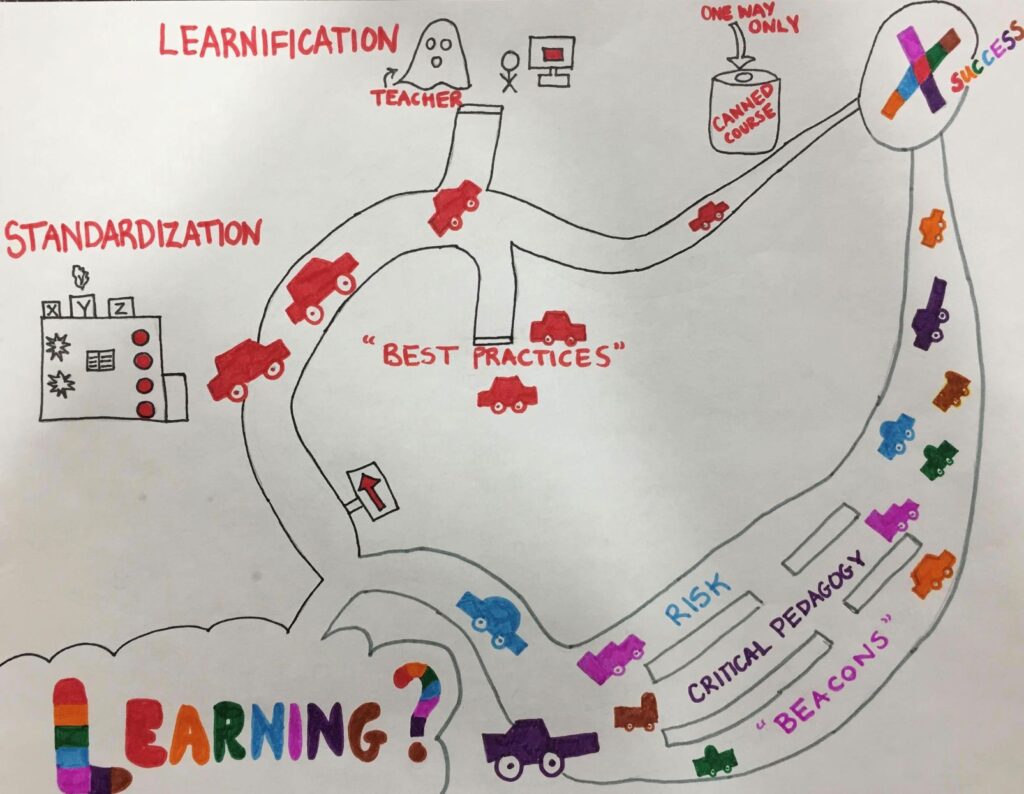The podcast Questioning Learning by Chris Friend and Amy Collier was very insightful, informative and had me questioning a lot about how students learn and how we teach both in the classroom and online.
My overall experience in constructing a sketchnote can be compared to that of a roller coaster ride. It was full of ups and downs, but at the end of the ride it was well worth it. I ran into a couple of challenges along the way while creating this artifact, such as trying to find a way to express the podcast in the form of images and single words or phrases. If I had any suggestions for future users it would be to make sure you clearly lay out how you are going to connect your ideas through the use of colour, arrows, word size, etc., to ensure that it is easy to follow for the reader. Sketchnotes are a creative way to speak your mind. At the end of the day all you need is a little perseverance, imagination, creativity and a pen and paper. I would definitely do a sketchnote again and would recommend its use to future students.

According to the podcast message, the concept of “best practice” can be described as a standard way to teach, the idea that a specific way is best, and that all students can learn in that same way. This way of thinking is based on standardization, which in my opinion is a process that should be avoided in the classroom. It is important to use critical pedagogy, and question whether or not this is the best way of teaching? Why? For whom?Instead of finding the best way to simply teach all students we should be inquiring and experimenting with how specific students learn best from our teaching practices and adjusting our teaching style based on how they learn and what we’re teaching.
The article mentions online courses being like “canned courses,” meaning the course is designed so that students do the same assignment, go through the same path, in the hope that they finish by gaining the same credentials at the end of the course. The teacher is merely there to grade assignments and answer questions when needed. Collier presents the idea of virtual office hours and bringing in online speakers. As a teacher, if I was selected to be an online teacher, I would definitely include virtual office hours and online speakers as well as add other creative ways to build that student-teacher relationship within the online world.

Using “Beacons instead of outcomes.” In my classroom, I would take the time to help guide my students in creating outcomes; goals that should be accomplished by the end of the unit. The notion of creating outcomes to be interesting and inspiring (beacons), as mentioned in the video, really resonated with me. I think the idea of transforming outcomes into big questions is a great idea. In this way, students know what is expected and can also come up with their own way to answer the questions at hand.

“Learnification” is another topic that can be described as the individualization of education with a focus on the student learning for themselves instead of attaining help from the teacher. In this case, the teacher can be seen as a “ghost” a figure that is still present in the classroom but out-of-reach for the student.

Once again, I believe that a teacher/student relationship is key in education. When you build that relationship, you are able to get to know your students and design lessons that are built to their specific needs and learning styles. In this case, learning is individualized for the student but there is still that essential bond between the student and their teacher.
To further explain my point, I believe the article demonstrates two main paths on the road to teaching and learning. The first would be the standardized “factory model” path, an environment in which everyone is conditioned to be like clones; depicted on the sketchnote by the red cars, brought up to learn the same way and hopefully reach the same goal in the same manner. You will have certain students who reach success since they may learn best through, or in spite of, that particular teaching style. However, you will also have a large number of “cars” that run out of gas, reach dead ends, get discouraged or give up and in the worse case scenario “dropout.”

Alternatively, I believe the article is demonstrating another “pathway to success”, one in which not all students are the same, one which acknowledges individuality and a multitude of learning differences. Students on this path can be depicted as cars of different shapes, colours and size, symbolizing that each individual comes in with prior knowledge, prior experiences and prior baggage that may have an impact on their learning. Drawing on my own personal teaching experiences working with a learning support teacher, no two children learn the same or reach the same goal at the same time. I would always try different tools for students whether that be hands on activities, comedy, demonstrations, examples, etc. and some tools would work better on one student and not at all on the other. Students may seek different avenues of learning, may branch out in different directions, obtain specific directions in order to reach their desired destination. No two people have to follow the same path in order to obtain success.

